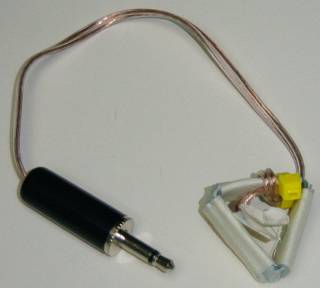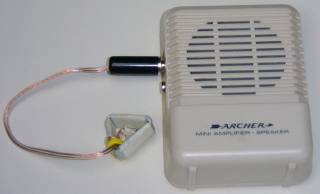


This is a simple inductor antenna design (the triangle thing) plus a high gain amplifier to turn electronic "noise" into something audible. This is very similar to the one designed by Foxx of BSoD.
This particular unit was designed to be small and portable and fit in my belt pack. The overall design can easily scale up or down based on the same principles, though.
The "triangular thing" is an air-core inductor wound out of some salvaged 30ga wire from a dead electric motor (about 20ft worth). It has a resistance of about 20ohm. The more wire, the more "RF noise" that will be picked up. RF noise is usually pretty weak and only a few loops for the inductor won't do it for volume. The triangle spindle was just cut and folded out of some recycled plastic and taped over. Each side is about 2cm. Don't leave any exposed metal showing for risk of shorting something out.
Just about any air-core inductor would work (home made or bought). I don't recommend toroidal, though. Iron-core inductors would not work very well for this as the central metal core would absorb some of the "RF noise" and damp the sound.
Sooner or later I'm going to grab some more of my dead motor magnet wire and wrap it around the end of a dead pen for another probe that would be easier to stick into tight places. Inductor probes can be made to look like just about anything so long as there is a coil of wire for the pickup and nothing metal blocking the RF signals.
Given the nature of RF signals, different antenna sizes and lengths are going to be better at picking up different frequencies. Different antennas and amps will make slightly different sounds (based on the harmonics picked up). If a person is really serious and needs a stethoscope like this, make or get inductor probes of varying sizes, have a good amp, and have good playback speakers.
The connecting wire is just cheap and easy 24ga speaker zip cord. It was tied around the triangle and zip tied off for strain relief. For an inductor probe with long runs, get some wire that has an independent shield around it and connect that shield to ground. This will avoid picking up noise along the wire run. Remember that the connecting wire is just as much of an antenna as the inductor coil on the end.
I used a 1/8" mono audio connector on mine so I could plug into my pocket amp. The connector type really doesn't matter so long as it fits what you want to plug it into. If a shield wire is used, it would be better to have another terminal/pin on the connector and run that directly to power supply ground.
I inherited the pocket amp a long time ago, and it runs off a 9v battery. This makes it ideal for portablility. Opening up the back, it is based off an LM386D with high gain. It can also accept headphones making it easier to block room noise to hear low level sounds.
A computer sound card could be used if an amp isn't available, but the quality will vary. The "mic input" jack should be able to handle something like this. If the inductor probe starts heating up, unplug it immediately.
Portable speakers designed for portable media players may work, but these are designed for close to line level signals and may not have enough gain to be practical.
Headphone amps may work if their input has a high enough gain. The same goes for pre-amps. Guitar pre-amps are designed for these low levels and may make a good choice and are often battery powered in pedal form.
Making your own generic pre-amp is an option and not too difficult. This could be op-amp or transistor based and be used for other projects as well. The LM386D mentioned before is common, cheap, relatively powerful, and easy to wire. Other op-amps offer higher quality and are powerful enough to run small headphones (add current boosters if powering speakers).
In a pinch, a portable AM radio could be used as a stethoscope, but it won't pick up as many frequencies and would be bulky to maneuver around.
So the electronic stethoscope is built, what can it do?
You can listen to the pops, whirrs, clicks, buzzes, and chirps of your electronics. With some ear training, you can learn to identify data transfers, processing, standby mode, and electric motors (fans and hard disks). When tracking down hardware problems, this can be invaluable. On the flip side, if nothing is picked up on a chip when something should be, the surrounding area is bad or the chip is dead/blown (this comes in handy for hard disk controller testing).
As an example, my cell phone makes some very obvious RF noises when communicating with the tower. It will start buzzing the stethoscope before a call actually rings. A call is a constant buzz and an SMS is a short buzz sequence. It will periodically check in with the tower in idle mode. The phone internal processor actually has something that sounds like a "heartbeat" when in standby mode. When bluetooth is active, another buzzing sound comes into play.
Another example is using the stethoscope to track down errant noise in an audio system. Some transformers can be more noisy than others. Light dimmers can put out a lot of noise. Flourescent lights are known to produce a lot of RF noise (some more than others). Sometimes the shielding or grounding isn't good enough on a nearby chip (especially digital ones). A fan (being an electric motor) may be putting out too much noise and may need more shielding, filtering, or to be physically moved away.
Another example is using the stethoscope to test infrared remote controls (like for TV's and movie players). Most will make some type of chip or chirp sound depending on the transmit frequency. Multi-room remotes use RF instead of IR, but they should make noise just the same.
Add a reflector dish (like a windsurfer) for directionality and something like this could be used to track down errant RF noise over longer distances.
A variation on the inductance probe has been used with a microprocessor and power lines to see if the electricity is active or not (this works with AC, not DC). It could be used to tell if a building has power and if a light in a room is on or off (good for alarm systems and home automation).
What this project will not do is snoop in on RF conversations people are having (like with analog phones) or FRS radios. That requires a tuned circuit and sometimes a special decoder.